Dossier: deaths in police custody
Since 2016, Controle Alt Delete has monitored the number of people who die during or after an arrest, and as a result of police violence. Based on this, Controle Alt Delete examines, among other things, the migration background of victims, whether they were in a mental health crisis, and whether the involved law enforcement officer(s) were prosecuted. These data show that, for the period from 2016 through November 2025:
Fatal incidents:
- So far, 116 people have died during or after an arrest;
- On average, 11 people die each year, roughly one per month.
Deaths caused by police violence:
- So far, 78 people have died as a result of police violence.
- 80% of the victims of police violence had a migration background.
- 49% of the victims exhibited “confused” or misunderstood behaviour.
- Since 2016, not a single officer has been convicted for police violence resulting in death.
Our goal
Service to, and safety for, all people should be the highest priorities of the police. We believe that the police should explicitly commit to goal zero: the aim that no one dies while under the responsibility of a law enforcement officer. Until that goal is achieved, we work to ensure that:
- Every person who dies during or after an arrest is given a voice and a face;
- Bereaved families receive the appropriate aftercare
- Research provides insight into how many people who died had a migration background and/or exhibited “confused” or misunderstood behaviour;
- All cases in which someone dies due to police violence are assessed by an independent judge.
Why does Controle Alt Delete monitor these cases?
After the death of Mitch Henriquez in 2015, Controle Alt Delete began monitoring deaths. The reason for this was that the police and the Public Prosecution Service (OM) were not transparent about the number of people who died during or after an arrest. Until 2020, the Public Prosecution Service only published information about people who died as a result of a police bullet. Individuals such as Mitch Henriquez, Bekim Hassani, and Umaru Sesay—who did not die from a police bullet—did not appear in these publications. Pressure from Controle Alt Delete contributed to the OM’s decision, starting in 2021, to provide an annual overview of all investigations conducted by the Rijksrecherche after people died under the responsibility of law enforcement officials. In connection with this, Bureau Beke conducted a study on fatal incidents.
We document deaths to make visible the circumstances under which people die during or after an arrest. By gathering this information, we gain insight into the nature of these incidents, the backgrounds of the victims, and the degree of transparency in police actions.
What do we classify as ‘death during or after an arrest’?
We register:
- Deaths where individuals died during their arrest, during transport to the police station, at the police station, or—after arrest—in the hospital.
- Deaths where it is unclear who was involved, where the person died, or in what way the death occurred. We register these based on the annual reports of the Public Prosecution Service, which state how many investigations into fatal incidents were carried out (the so-called TSI investigations).
- Deaths following a collision involving a police car or motorcycle.
We do not register:
- Single-vehicle traffic accidents (without a police vehicle being directly involved), for example during an attempted escape. These fall outside our registration because the police do not have a direct physical role in such incidents.
- Deaths by suicide, unless there was (possibly) a case of suicide by cop.
- Deaths of people serving a prison sentence in a detention facility. These fall under the responsibility of the prison system, not the police.
What do we classify as ‘death after police violence’?
Controle Alt Delete monitors fatal incidents and examines, within those cases, whether people died as a result of police violence. We classify a case as “death after police violence” when a person dies following the use of force by the police during an arrest, during transport, or in a police cell. Whether a death falls under this definition is determined based on fixed criteria. These criteria align with the definitions used by the American Mapping Police Violence (MPV) and the European Police Lethal Force and Accountability (PLFA).
We register deaths that meet the following criteria:
- Deaths that result from, or can be associated with, the use of force by the police. This may involve physical force, such as handcuffing and/or the use of weapons.
- Deaths following traffic incidents are recorded only if a police vehicle was used as an instrument of force—for example, during ramming or blocking manoeuvres.
- Deaths in which the force was applied by law enforcement officials, such as police officers or personnel of the Royal Netherlands Marechaussee. We do not register deaths caused by violence from civilians or private security guards. However, we do register deaths involving force used by police officers in cooperation with civilians or private security guards.
- Deaths in which a person became “unwell” during an arrest, during transport, or in a police cell. We include such cases because they may be associated with the use of force.
How does Controle Alt Delete monitor these cases?
For this overview of fatal incidents, three different sources were used:
- Controle Alt Delete’s registrations (since 2016),
- The study on fatal incidents conducted by Bureau Beke (2016–2020, commissioned by the Rijksrecherche), and
- The annual reports of the Public Prosecution Service (since 2021).
Controle Alt Delete Controle Alt Delete has monitored all people who die during or after an arrest since 2016. To do so, we closely follow media reports, police statements, and press releases from the Public Prosecution Service. This allows us to identify all deaths associated with fatal incidents.
Bureau Beke In 2022, Bureau Beke published a report on fatal incidents during the period 2016 to 2020. The researchers were given access to the case files of the Rijksrecherche, which conducted the investigations. Bureau Beke did not use data that Controle Alt Delete had previously collected. As a result, fatal incidents that the Rijksrecherche did not investigate were not included in this study.
Public Prosecution Service (OM) The Rijksrecherche investigates fatal incidents on behalf of the Public Prosecution Service (OM). The OM determines whether an incident will be investigated and may decide not to investigate certain cases. This occurs, for example, when the OM determines that there was no criminal conduct by the police. The Rijksrecherche focuses on incidents in which possible criminal behaviour is involved. Not all fatal incidents fall under this criterion. As a result, some deaths are registered by Controle Alt Delete, while the Rijksrecherche does not investigate them. Finally, the OM sometimes publishes a press release once an investigation is completed, but this does not always occur.
How many people die each year in the Netherlands?
In the period from 2016 through november 2025, at least 116 people died in a fatal incident. For some deaths, it is known that they occurred under the responsibility of law enforcement officers, even when no information is available about what happened. Below we explain this in more detail:
2016: Bureau Beke documented that the Rijksrecherche investigated 9 fatal incidents. Controle Alt Delete registered 10 fatal incidents, including one death following a collision. The collision was investigated by the Rijksrecherche but is not registered by Controle Alt Delete as a fatal incident. Based on the figures from Controle Alt Delete and the Rijksrecherche, at least 10 people died in a fatal incident in 2016, of whom at least 9 died due to police violence. For one person, the cause is unknown to us.
2017: Bureau Beke documented that the Rijksrecherche investigated 10 fatal incidents, including one death by suicide. This case was investigated by the Rijksrecherche but is not registered by Controle Alt Delete as a fatal incident. Controle Alt Delete registered 7 fatal incidents. Based on both sets of figures, at least 9 people died in a fatal incident in 2017, of whom at least 7 died due to police violence. For 2 people, the cause is unknown to us.
2018: Bureau Beke documented that the Rijksrecherche investigated 9 fatal incidents. Controle Alt Delete registered 7 fatal incidents. All cases registered by Controle Alt Delete were investigated by the Rijksrecherche. Based on the figures, at least 9 people died in a fatal incident in 2018, of whom at least 7 died due to police violence. For 2 people, the cause is unknown to us.
2019: Bureau Beke documented that the Rijksrecherche investigated 10 fatal incidents. Controle Alt Delete registered 9 fatal incidents, including a man who died after a collision with a police car. For unknown reasons, this fatal collision was not investigated by the Rijksrecherche. Based on both sources, at least 11 people died in a fatal incident in 2019, of whom at least 8 died due to police violence, one due to a collision, and for two people the cause is unknown to us.
2020: Bureau Beke documented that the Rijksrecherche investigated 16 fatal incidents. Controle Alt Delete registered 15 fatal incidents. One incident was not investigated by the Rijksrecherche, but Controle Alt Delete does register it as a fatal incident because the homeless person died after being arrested. Based on the combined figures, at least 17 people died in a fatal incident in 2020, of whom at least 14 died due to police violence. For 3 people, the cause is unknown to us.
2021: The Public Prosecution Service (OM) documented that the Rijksrecherche investigated 12 fatal incidents. Controle Alt Delete documented 6 fatal incidents, including a fatal collision. All fatal incidents registered by Controle Alt Delete were investigated by the Rijksrecherche, including the fatal collision. Based on both sources, at least 12 people died in a fatal incident in 2021, of whom at least 5 died due to police violence, one due to a collision, and for 6 people the cause is unknown to us.
2022: The OM documented that the Rijksrecherche investigated 20 fatal incidents. Controle Alt Delete registered 10 fatal incidents, including a cyclist who died in a collision with the Royal Netherlands Marechaussee (KMar). This collision was not investigated by the Rijksrecherche but was reviewed internally by the KMar. Based on these figures, at least 21 people died in a fatal incident in 2022, of whom at least 9 died due to police violence, one due to a collision, and for 11 people the cause is unknown to us.
2023: The OM documented that the Rijksrecherche investigated 7 fatal incidents. Controle Alt Delete registered 3 fatal incidents. The Rijksrecherche investigated the deaths of two people who drove on the wrong side of the highway while fleeing from the police and were killed. This incident is not registered by Controle Alt Delete as a fatal incident. Based on both sources, at least 5 people died in a fatal incident in 2023, of whom at least 3 died due to police violence, and for 2 people the cause is unknown to us.
2024: The OM documented that the Rijksrecherche investigated 11 cases. Controle Alt Delete registered 4 fatal incidents. Additionally, Controle Alt Delete registered two incidents requiring mention. First: two men died during a chase after a collision with a train. This fatal collision was investigated by the Rijksrecherche but is not registered by Controle Alt Delete as a fatal incident. Second: a motorcyclist died after a collision with a police car. This incident was not investigated by the Rijksrecherche but is registered by Controle Alt Delete as a fatal incident. Based on the figures, at least 6 people died in a fatal incident in 2024, of whom at least 4 died due to police violence, one due to a collision, and for one person the cause is unknown.
2025: The fatal incidents for 2025 are published on https://overleden.controlealtdelete.nl/. In May 2026, the OM will publish its most recent annual report, and the information for 2025 will be updated.
How many officers appear before a judge each year?
In fatal incidents in which police violence did not play a role, officers were prosecuted and convicted in two cases. Both involved traffic accidents with a fatal outcome.
In fatal incidents in which someone died due to police violence, officers have appeared before a judge in two cases:
- A police officer involved in a fatal shooting in 2018 was not prosecuted by the Public Prosecution Service (OM), but did appear before the criminal court after bereaved relatives initiated an Article 12 Sv procedure. The officer was acquitted by the court.
- A police officer involved in a fatal shooting in 2022 was prosecuted by the OM. This officer was subsequently acquitted by the court.
The OM announced that it will prosecute eight officers who were involved in a fatal incident in 2023. As of October 2025, this prosecution had not yet begun.
Since 2016, two officers have therefore been prosecuted for police violence resulting in death. Since 2016, not a single officer has been convicted for police violence resulting in death.
Do more people with a migration background die?
Of the 116 cases documented by Controle Alt Delete in the period from 2016 through November 2025, 79 people died due to police violence.
- For 33 victims, their background is unknown.
- Of the remaining 46 victims, 80% had a migration background and 20% did not.
In 2024, there were 5 million residents in the Netherlands with a migration background and 12.9 million residents without a migration background.
- Among residents with a migration background, 0.82 people per million inhabitants per year died due to police violence.
- Among residents without a migration background, 0.08 people per million inhabitants per year died.
This shows that residents with a migration background died under the responsibility of law enforcement officers at a rate approximately 11 times higher than would be expected based on their share of the population.
For comparison: in the United States, Black Americans die at the hands of law enforcement 3.3 times more often than white Americans, relative to their share of the population.
Background information on the deceased
It is important to give face and voice to each person who dies under the responsibility of law enforcement officials. Controle Alt Delete has looked at the figures regarding name known / unknown, migration background, ‘confused behavior’, cause of death (police bullet or other cause of death), city and prosecution of involved officers. From that, over the period 2016 through 2022, the following trends emerges:
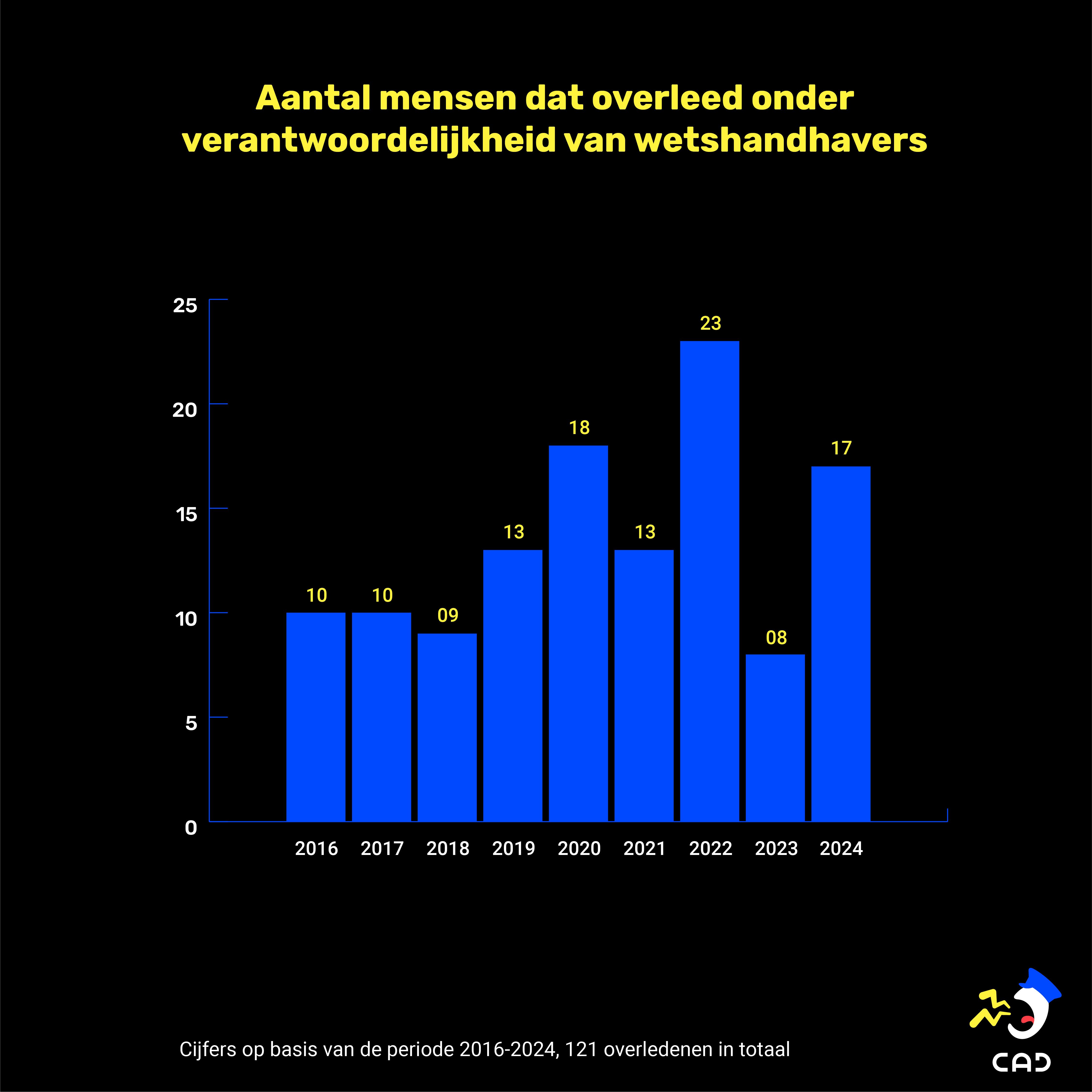
Number of deaths
Controle Alt Delete has been investigating how many people die under the responsibility of law enforcement since 2016. In 2016 we registered 10 victims, also 10 in 2017, 9 in 2018, 12 in 2019, 18 in 2020, 13 in 2021, 23 victims in 2022, 8 victims in 2023 and 17 victims in 2024.
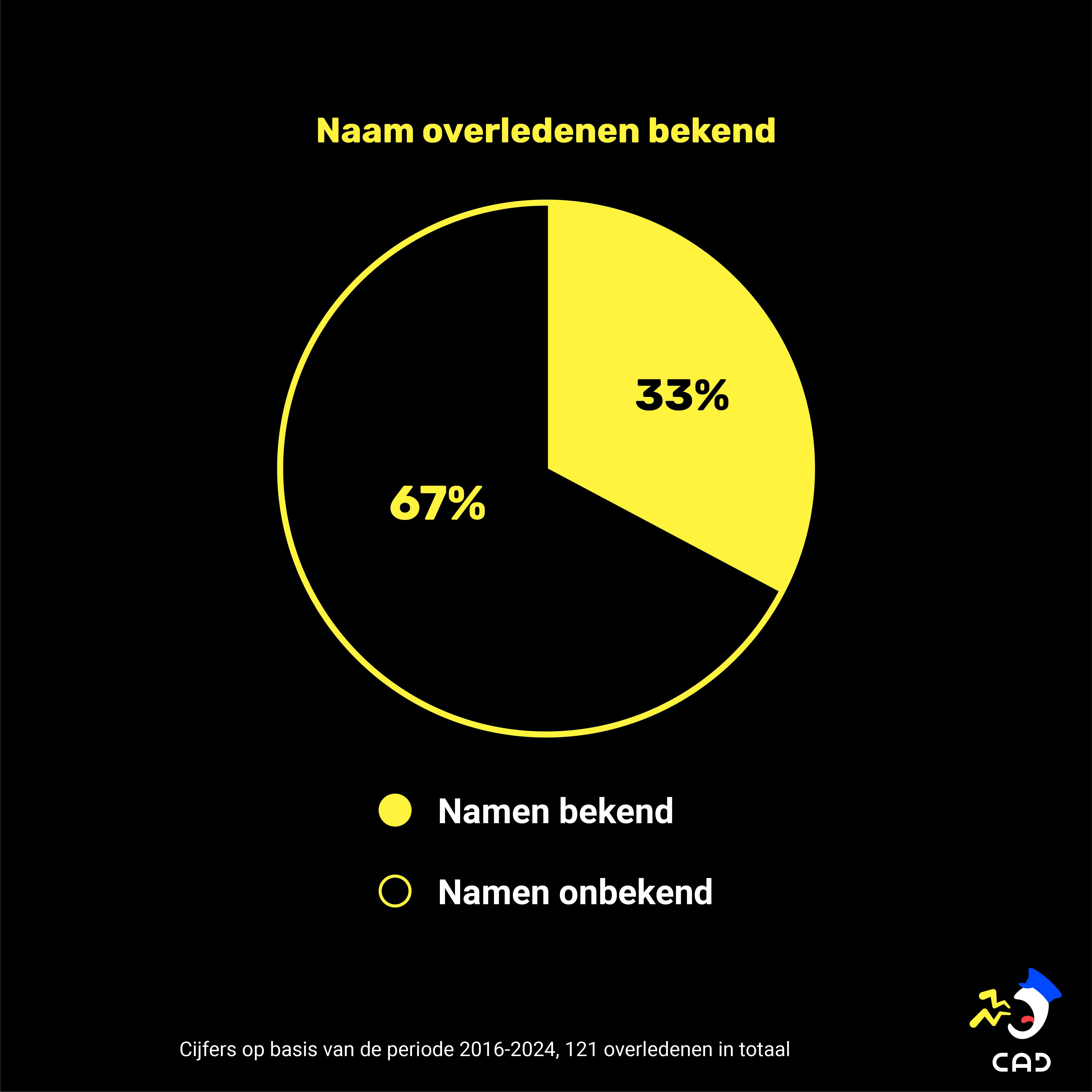
Name known/unknown
Of the 121 people who died, the name is known for 33%. For 67%, the name remains unknown. These individuals cannot be given a voice or a face.
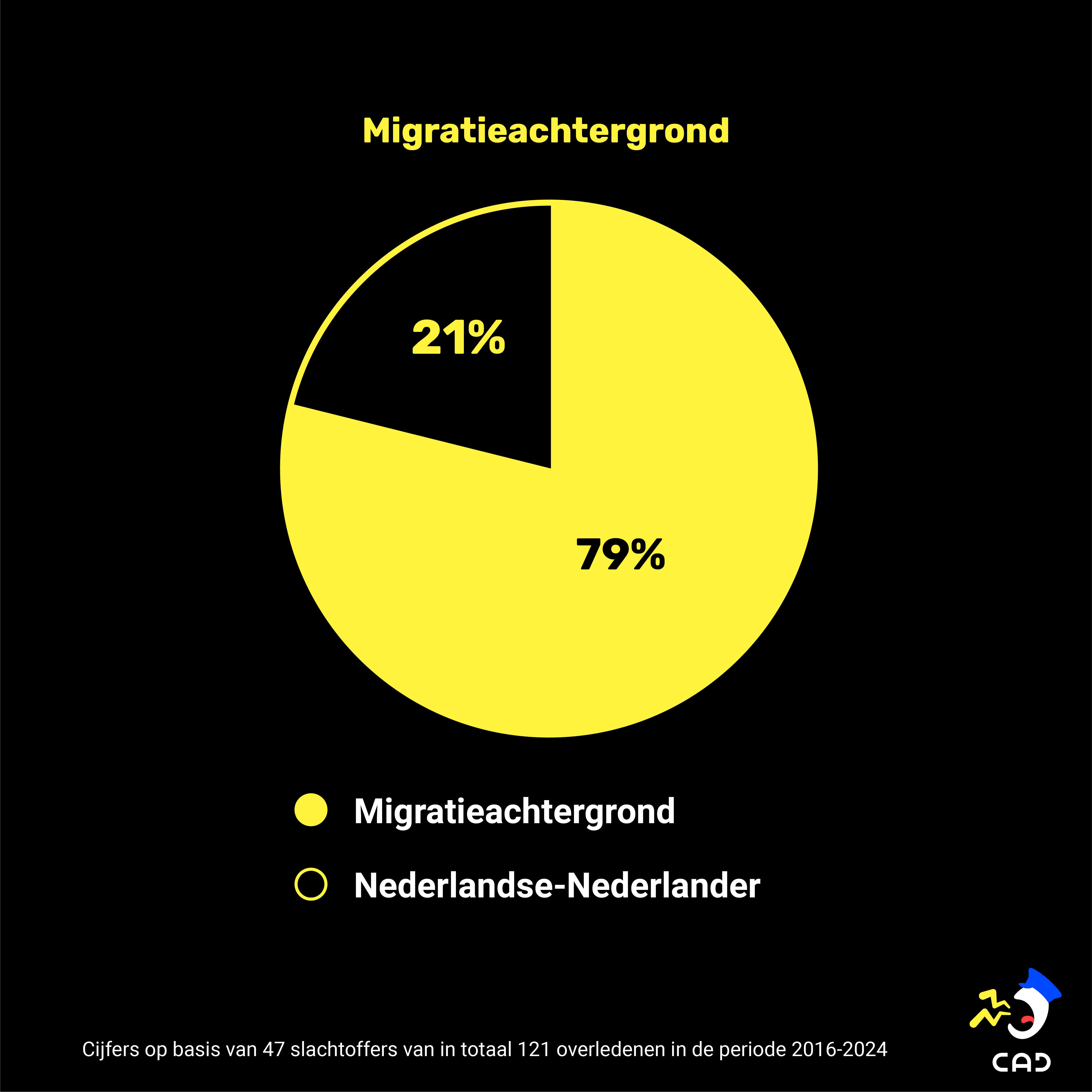
Migration background
Of the individuals whose background is known, 79% have a migration background, and 21% do not have a migration background.
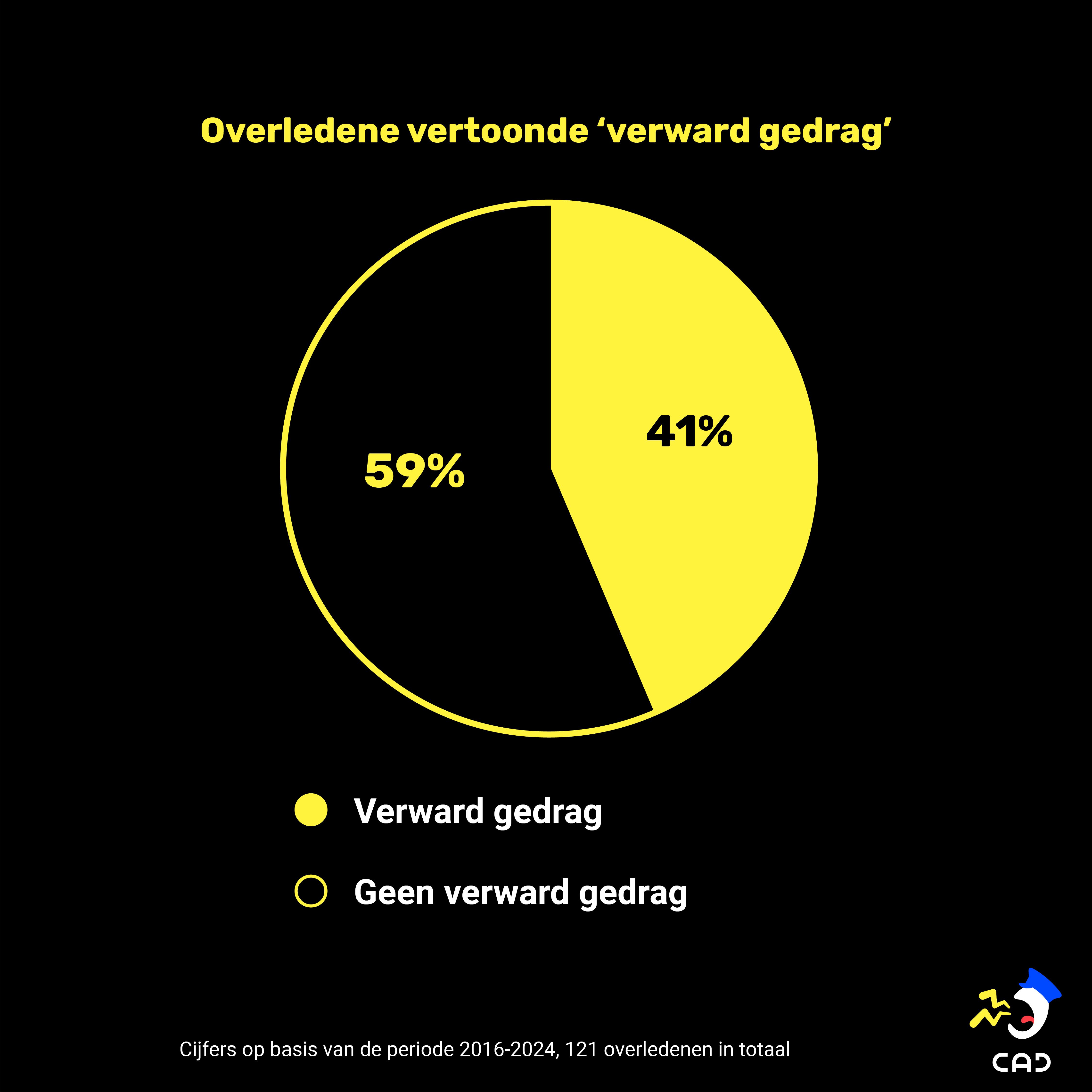
Mental health crisis
41% of the people who died were experiencing a mental health crisis. In 35 of these 50 cases (70%), the police were aware of this before arriving at the scene.
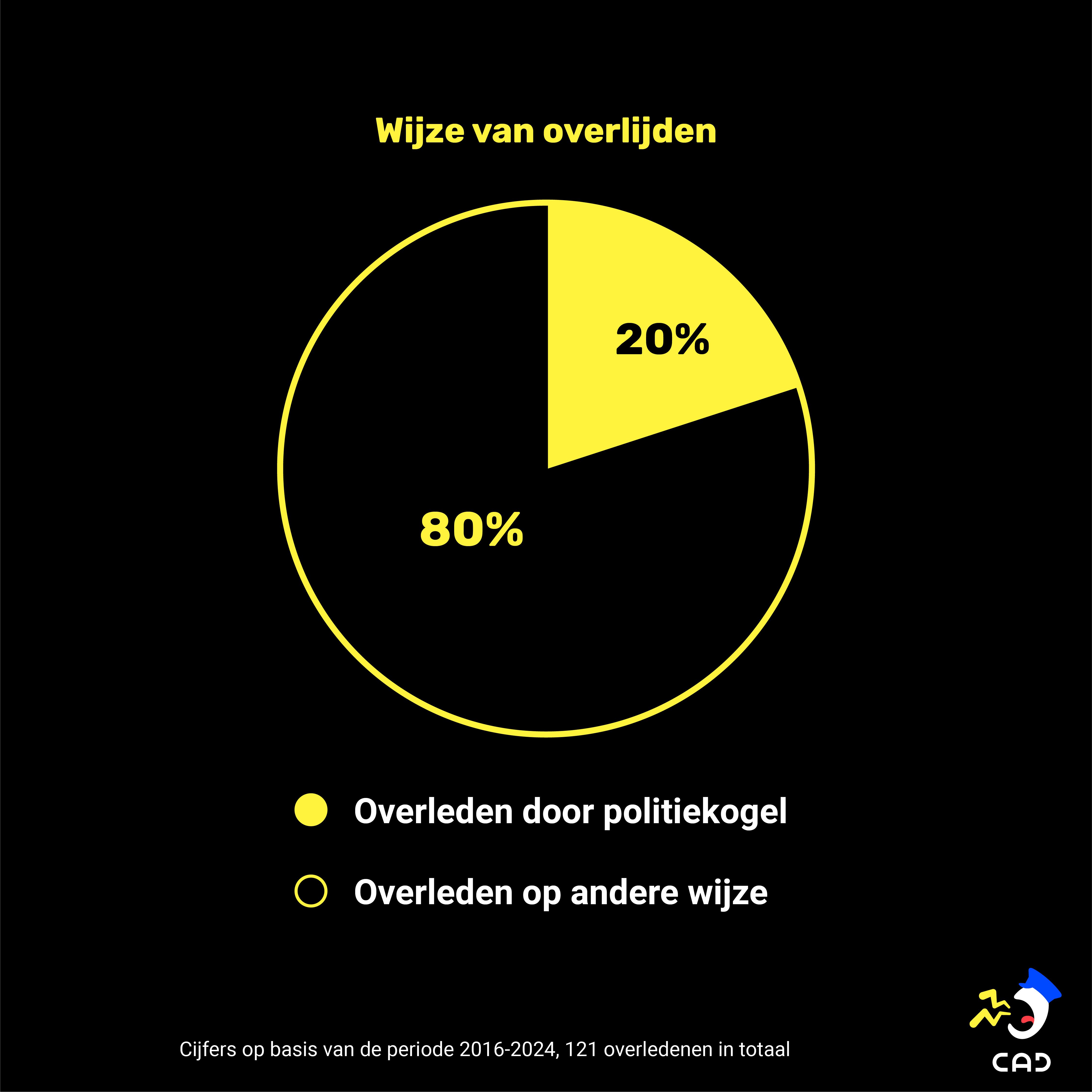
Cause of death
24 of the 121 people (20%) died from a police bullet, 95 people (78%) died in another way. It is unknown for 3 people (3%).
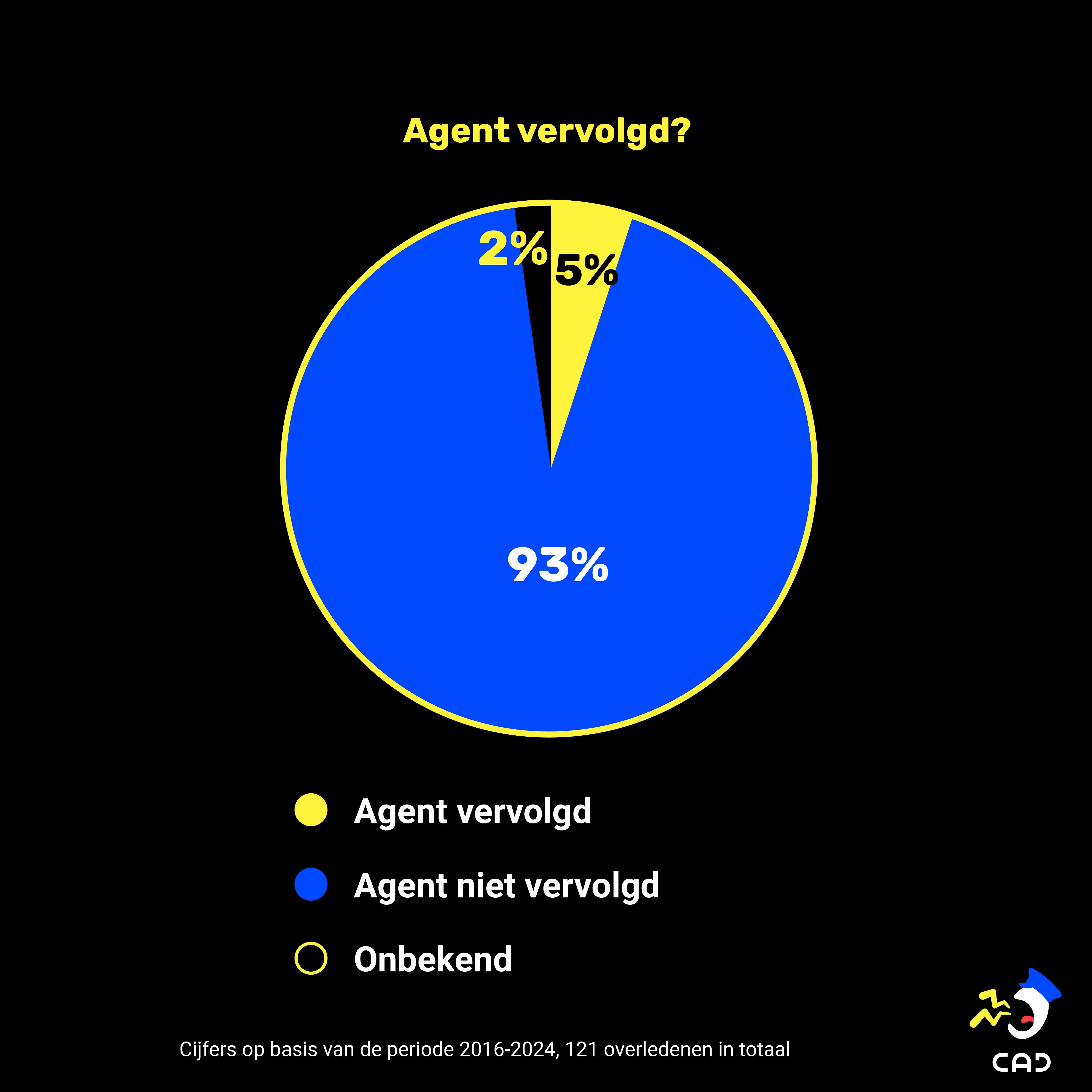
Prosecution of law enforcement officials
In six cases (5%) of fatal incidents, a law enforcement officer was prosecuted by the Public Prosecution Service. In two cases, this led to a community service sentence, in three cases the officers were acquitted. In one case the prosecution hasn’t started yet. In 88% of fatal incidents, no officer was prosecuted. In 7% of cases, the outcome is unknown.
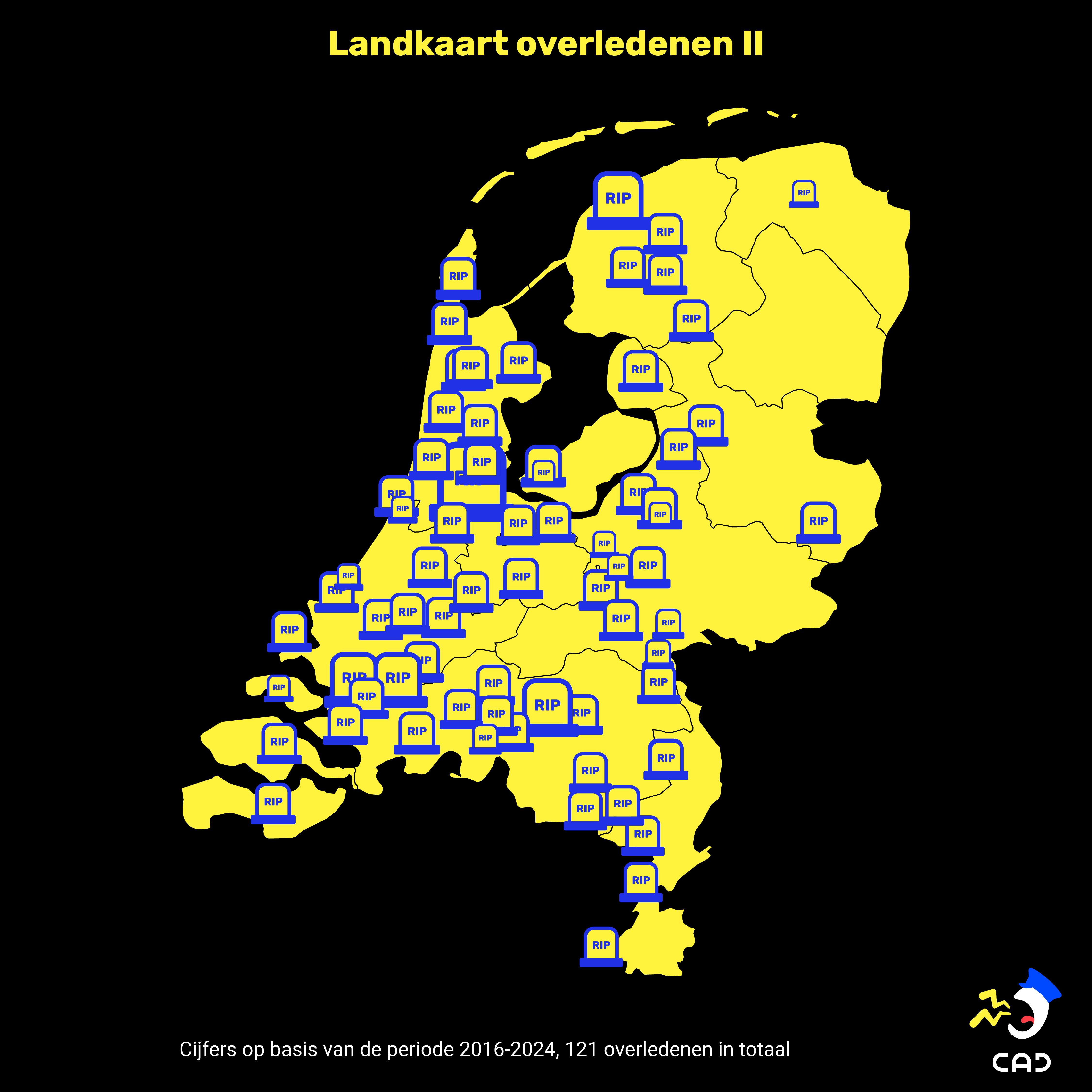
Incident map
Most deaths occurred in the western part of the Netherlands. In the Amsterdam police unit, there were 16 cases, in the Rotterdam unit 12, in East Netherlands 13, in Zeeland West-Brabant 10, in North Netherlands 9, in East Brabant 9, in The Hague 6, in Central Netherlands 5, in Limburg 6, and 4 in North Holland. For 32 individuals, the location is unknown.
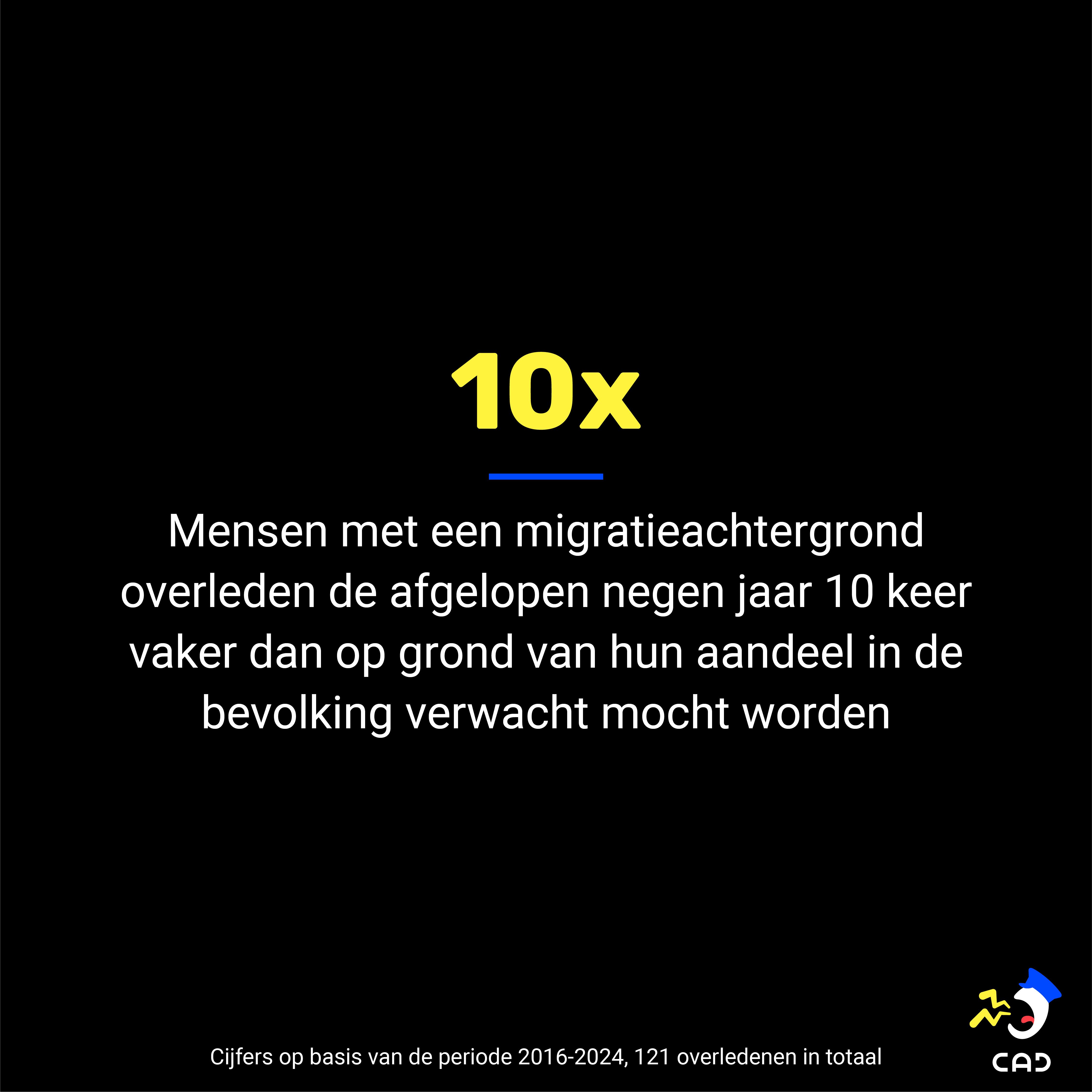
Disproportionality
In the Netherlands, people with a migration background die under law enforcement responsibility 10 times more often than people without a migration background than would be expected based on population size. By comparison: In the United States, Black Americans die 2.5 times more often than white Americans under law enforcement responsibility, relative to their population share.